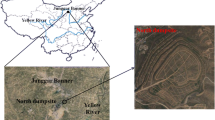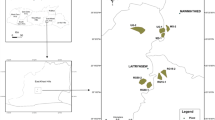Abstract
The ecological restoration of mining areas has always been emphasized in ecological research. This study has investigated herb species diversity of plantations in a reclamation area of the Antaibao opencast coal mine in China after 6 years, aiming to investigate the changes over time and spontaneous succession patterns. One hundred fifty-six species of naturally colonizing herb belonging to 26 families and 86 genera in the six plantations were chosen. Most of 24 herb-dominant species belong to Gramineae, Compositae, and Papilionaceae. Species diversity, meteorology, and soil were recorded. Over time, although the dominant degree of Gramineous has decreased and the degree of Labiatae and Polygonaceae has increased, it still indicated that Gramineae, Compositae, and Papilionaceae occupied an important position in the herb community and played an important role in natural vegetation recovery in reclamation area of the Antaibao opencast coal mine. The diversity of herb species showed significant differences between different plots and years. Correlation analysis indicates that the most important factors for herb species diversity are soil bulk density, average winter temperature, and the mean autumn rainfall.



Similar content being viewed by others
References
Aarssen LW (1997) High productivity in grassland ecosystems: effected by species diversity or productive species? Oikos 80:183–184
Allen SE (1989) Chemical analysis of ecological materials (2nd edition) (p. 368). Blackwell Scientific Publications, Oxford
Bai ZK, Guo QX, Wang GL, Zhang QJ, Wei ZY (2001) The evolution and disposition of benefit of land reclamation and ecological rehabilitation in mining area. J Nat Resour 16(6):525–530
Billings W (1938) The structure and development of old-field pine stands and certain associated physical properties of the soil. Ecol Monogr 8:437–499
Bradshaw AD (1989) Wasteland management and restoration in Western Europe. J Ecol 26:775–786
Bremner JM, Keeney DR (1966) Determination and isotope-ratio analysis of different forms of nitrogen in soils: 3. exchangeable ammonium, nitrate, and nitrite by extraction-distillation methods. Soil Sci Soc Am J 30 (5):577–582
Cao YG, Wang JM, Bai ZK, Zhou W, Zhao ZQ (2015) Differentiation and mechanisms on physical properties of reconstructed soils on open-cast mine dump of loess area. Environ Earth Sci 7:6367–6380
Dave C, Cathy R, Laura H, Lorraine P (2007) Plant colonization and arsenic uptake on high arsenic mine wastes, New Zealand. Water Air Soil Pollut 179:351–364
Diaz S, Cabido M (2001) Vive la difference: plant functional diversity matters to ecosystem processes. Trends Ecol Evol 16:646–655
Fan YH, Lu ZH, Cheng JL, Zhou ZX, Wu G (2003) Major ecological and environmental problems and the ecological reconstruction technologies of the coal mining areas in China. Acta Eclogica Sinica 23(10):2144–2152
Glenn-Lewin D, Peet R, Veblen T (1992) Succession: theory and prediction (pp. 180–190). Chapman & Hall, London
Grace JB (1999) The factors controlling species density in herbaceous plant communities: an assessment. Perspect Plant Ecol Evol Syst 2:1–28
Grau HR, Aide TM, Zimmerman JK, Thomlinson JR, Helmer E, Zou XM (2003) The ecological consequences of socioeconomic and land-use changes inpostagriculture Puerto Rico. Bioscience 53:1159–1168
Grime JP (1998) Benefits of plant diversity to ecosystems: immediate, filter and founder effects. J Ecol 86:902–910
Heshmatti G, Squires VR (1997) Geobotany and range ecology: a convergence of thought? J Arid Environ 35:395–405
Kahmen A, Perner J, Audorff V, Weisser W, Buchmann N (2005) Effects of plant diversity, community composition and environmental parameters on productivity in montane European grasslands. Oecologia 142:606–615
Lavoiel C, Grosvernier P, Girard M, Marcoux K (2003) Spontaneous revegetation of mined peatlands: an useful restoration tool? Wetl Ecol Manag 11:97–107
Lawton JH (1994) What do species do in ecosystems. Oikos 71:367–374
Leendertse P (1997) Long-term changes (1953–1990) in the salt marsh vegetation at the Boschplaat on Terschelling in relation to sedimentation and flooding. Plant Ecol 132:49–58
Li SQ, Wu DM, Zhang JT (2005) Effects of vegetation and fertilization on weathered particles of coal gob in Shanxi mining areas, China. J Hazard Mater 124:209–216
Li SQ, Yang BS, Wu DM (2008) Community succession analysis of naturally colonized plants on coal gob piles in Shanxi mining areas, China. Water Air Soil Pollut 193:211–228
Luisa M, Gabriela V, Salvador S (2001) Spatial and temporal variability during primary succession on tropical sand dunes. J Veg Sci 12:361–372
Mehlich M (1984) Mehlichs-3 soil test extractant: a modification of the Mehlich 2 extractant. Commun Soil Sci Plant Anal 15:1409–1416
Nie YY, Li XE, Wang G (2010) Variation mode of α diversity and β diversity of plant community of different habitat gradients from south-facing slope to north-facing slope and its relation with different environmental factors. J Lanzhou Univ (Nat Sci) 46(3):74–79
Ottoa R, Krüsi BO, Burgac CA, Fernández-Palaciosa JM (2006) Old-field succession along a precipitation gradient in the semi-arid coastal region of Tenerife. J Arid Environ 65:156–178
Parkinson JA, Allen SE (1975) A wet oxidation procedure suitable for the determination of nitrogen and mineral. Commun Soil Sci Plant Anal 6:1–11
Peet RK (1974) The measurement of species diversity. Ann Rev Ecol Syst 11(5):285–307
Rayment GE, Higgingson FR (1992) Australian laboratory handbook of soil and water chemical methods. Inkata Press
Walkley A, Black IA (1934) An examination of the Degtjareff method for determining soil organic matter and a proposed modification of the chromic acid titration method. Soil Sci 38:29–38
Wang YF, Cai YC (1988) Studies on genesis, types and characteristics of the soil of the Xilin River basin. Research on Grassland Ecosystem, (3):23–83
Wang LY, Guo DG, Bai ZK, ShangGuan TL (2012) Species composition and spatial pattern of understory herbaceous plants on an ecological rehabilitation site from open coal mining. Chin J Appl Environ Biol 18(3):399–404
Xu L, Zhou XC, Wang DM (2005) Progress on the reclamation of gangue waste area. Sci Soil Water Conserv 3(3):117–122
Yang SF, Fang WX, Hu RZ (2004) Advances in studying environmental impact and pollution control of coal mine waste in China. Bull Mineral Petrol Geochem 23:264–269
Yue JY, Guo CY, Li JC, Lu N, Wang X, Li QR (2016) Colonized wild plants in the reclamation area of the Antaibao opencast coal mine. Arid Zone Res 33(2):399–409
Zhang JT (2005) Succession analysis of plant communities in abandoned croplands in the eastern Loess Plateau of China. J Arid Environ 63:458–474
Zhang CL (2006) Analysis of current situation and trend of land desertification in coal mine area of Shanxi Province. Sci Soil Water Conserv 4(5):40–43
Zhang LX, Zhang F, Shangguan TL (2000) Vegetation diversity of Luya Mountains. Biodivers Sci 8(4):361–369
Zhang GL, Zhang JT, Guo XY (2005) Ecological relationships among artificial vegetations during their restoration in Antaibao mining area. Chin J Appl Ecol 16(1):151–155
Zhao JK (1993) The technologies for land reclamation and their management in mine. Chinese Agricultural, Beijing, p 125
Acknowledgments
We thank the members of the Plant Resource and Ecology Laboratory for help with data collection in the field.
Funding
The present study was supported by the National Natural Science Foundation of China (no. U1810107) and the Natural Science Foundation of Shanxi, China (no. 201701D121123).
Author information
Authors and Affiliations
Corresponding author
Ethics declarations
Conflict of interest
The authors declare that they have no competing interests.
Additional information
Responsible Editor: Philippe Garrigues
Publisher’s note
Springer Nature remains neutral with regard to jurisdictional claims in published maps and institutional affiliations.
Rights and permissions
About this article
Cite this article
Guo, C., Zhang, F., Wang, X. et al. Effects of meteorology and soil on the herb species diversity in plantations in a reclamation area of coal mine after 6 years. Environ Sci Pollut Res 27, 24231–24241 (2020). https://doi.org/10.1007/s11356-020-08402-2
Received:
Accepted:
Published:
Issue Date:
DOI: https://doi.org/10.1007/s11356-020-08402-2




